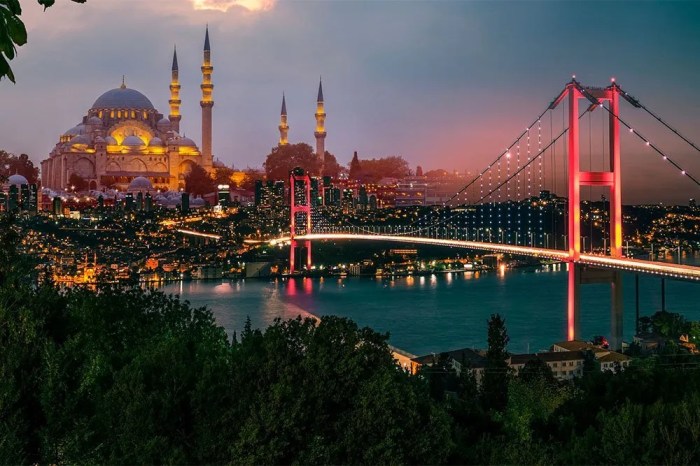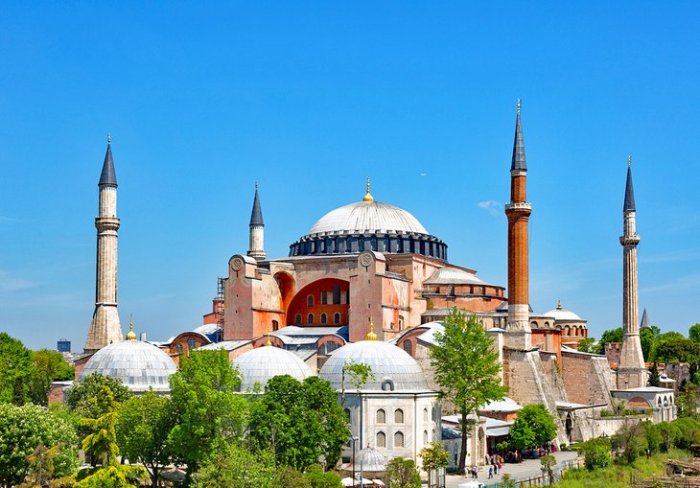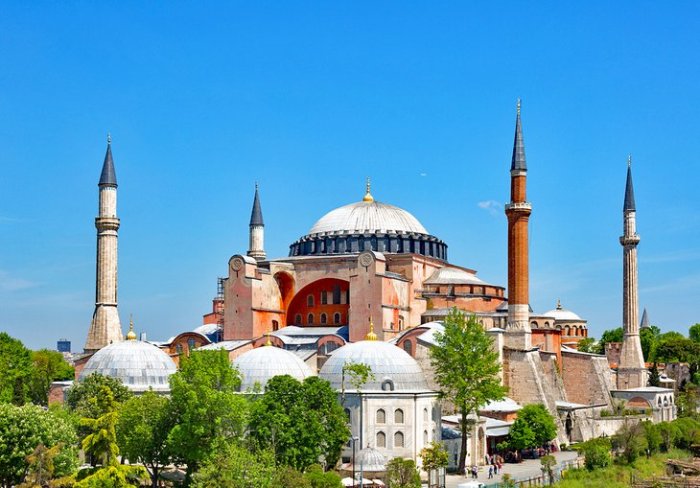Turkey natural attractions – Turkey’s natural attractions captivate visitors with their breathtaking beauty and geological marvels. From the surreal landscapes of Cappadocia to the pristine beaches of the Aegean Sea, Turkey’s diverse ecosystems offer a rich tapestry of natural wonders that tell the story of the country’s unique history and geography.
Embark on a journey through Turkey’s natural treasures, where ancient geological processes have shaped stunning landscapes and created a haven for diverse flora and fauna. Discover the enchanting beauty of Pamukkale’s travertine terraces, the awe-inspiring volcanic formations of Cappadocia, and the majestic peaks of Mount Ararat.
Geographical Features
Turkey, situated at the crossroads of Europe and Asia, boasts an incredibly diverse landscape shaped by complex geological processes over millions of years. Its rugged mountains, fertile valleys, and picturesque coastlines are a testament to the country’s unique geographical heritage.
Geological Processes
Turkey’s landscape has been shaped by various geological forces, including plate tectonics, volcanic activity, and erosion. The collision of the Eurasian and African plates has resulted in the formation of the country’s mountainous regions, while volcanic eruptions have created unique geological features such as Mount Ararat and Lake Van.
Mountain Ranges
- Taurus Mountains:Located in southern Turkey, these mountains are known for their rugged peaks and deep valleys, formed by the collision of the African and Eurasian plates.
- Pontic Mountains:Running along the Black Sea coast, these mountains are characterized by steep slopes and dense forests, shaped by the uplift of the Earth’s crust.
- Armenian Highlands:A vast plateau in eastern Turkey, this region is home to Mount Ararat, the legendary resting place of Noah’s Ark.
Valleys and Plateaus
- Mesopotamian Plain:This fertile valley in southeastern Turkey is formed by the Tigris and Euphrates rivers, and has been a cradle of civilization for thousands of years.
- Anatolian Plateau:A vast, semi-arid plateau in central Turkey, characterized by rolling hills and steppes, formed by volcanic activity.
Coastlines
Turkey’s coastline is divided into three distinct regions:
- Black Sea Coast:This region is characterized by steep cliffs, narrow beaches, and dense forests, shaped by the uplift of the Earth’s crust.
- Aegean Sea Coast:This region has a more gentle coastline with numerous islands, bays, and coves, formed by the submergence of landmasses.
- Mediterranean Sea Coast:This region boasts long, sandy beaches, clear waters, and a warm climate, shaped by the influence of the Mediterranean Sea.
Natural Wonders
Turkey boasts a plethora of breathtaking natural attractions that have captivated travelers for centuries. From the surreal landscapes of Cappadocia to the otherworldly beauty of Pamukkale, these wonders showcase the country’s rich geological history and awe-inspiring natural beauty.
Pamukkale
Pamukkale, meaning “cotton castle” in Turkish, is a natural wonder located in southwestern Turkey. It is renowned for its cascading white travertine terraces, formed by the deposition of calcium carbonate from hot springs. The terraces resemble a frozen waterfall, creating a surreal and picturesque landscape.
The warm, mineral-rich waters of the springs are believed to have therapeutic properties, attracting visitors seeking relaxation and rejuvenation.
Cappadocia
Cappadocia, in central Turkey, is a region of unique geological formations known as “fairy chimneys.” These cone-shaped rock structures were formed millions of years ago by volcanic eruptions and subsequent erosion. The soft volcanic rock was carved by wind and water into intricate shapes, creating a lunar-like landscape.
Cappadocia is also home to numerous underground cities and churches, built by early Christians seeking refuge from persecution.
Mount Ararat
Mount Ararat, located in eastern Turkey, is the highest peak in the country and a symbol of national pride. According to biblical tradition, it is believed to be the resting place of Noah’s Ark after the Great Flood. The mountain is a dormant volcano and its snow-capped summit offers panoramic views of the surrounding countryside.
Mount Ararat is a popular destination for hikers and mountaineers, and its historical and religious significance adds to its allure.
National Parks
Turkey is renowned for its stunning national parks, which showcase diverse ecosystems, rich biodiversity, and breathtaking landscapes. These protected areas play a crucial role in preserving the country’s natural heritage while offering visitors exceptional opportunities for exploration and recreation.
Göreme National Park
Göreme National Park, located in the Cappadocia region, is a UNESCO World Heritage Site famous for its unique geological formations, known as fairy chimneys. These surreal landscapes were shaped by volcanic eruptions and erosion over millions of years. The park is also home to numerous historical and cultural sites, including ancient churches, monasteries, and underground cities.
Visitors can embark on hiking trails through the otherworldly terrain, explore hidden valleys, and marvel at the intricate rock formations.
Uludağ National Park
Uludağ National Park, located in northwestern Turkey, encompasses the majestic Mount Uludağ, the highest peak in the country. The park boasts a diverse range of ecosystems, from lush forests to alpine meadows and rocky summits. It is a popular destination for hikers, climbers, and nature enthusiasts, offering scenic trails and stunning views of the surrounding mountains and valleys.
The park is also home to a variety of wildlife, including brown bears, wolves, and chamois.
Flora and Fauna

Turkey is home to an incredibly diverse array of flora and fauna, including numerous endemic species and migratory birds. Its unique geographical location at the crossroads of Europe, Asia, and Africa has contributed to this rich biodiversity.
Turkey’s wetlands and forests are vital habitats for a wide range of wildlife. The country has over 400 bird species, including migratory species such as storks, pelicans, and flamingos. Turkey is also home to a significant population of endangered species, such as the Anatolian leopard, the Mediterranean monk seal, and the green turtle.
Conservation Initiatives
Turkey has implemented several conservation initiatives to protect its endangered species and their ecosystems. These initiatives include the establishment of national parks and protected areas, as well as the implementation of conservation programs aimed at reducing habitat loss and hunting.
One of the most successful conservation initiatives in Turkey has been the protection of the Mediterranean monk seal. This species was once on the brink of extinction, but thanks to conservation efforts, its population has begun to recover.
Historical and Cultural Heritage
Turkey’s natural attractions have played a profound role in shaping the country’s history and culture. From ancient times to the present day, these wonders have inspired myths, legends, and artistic creations.
The Hittites, who ruled Anatolia from the 17th to the 13th centuries BC, believed that Mount Ararat was the sacred mountain where their gods resided. The Phrygians, who succeeded the Hittites, associated the Midas Mound with their legendary king Midas, who turned everything he touched into gold.
Mythology and Folklore
- Mount Ararat is believed to be the resting place of Noah’s Ark.
- The Bosphorus Strait is said to have been created by Zeus, the king of the gods, as a passage for the Argonauts.
- Lake Van is home to a legend about a monster that lives in its depths.
Architecture
- The Hagia Sophia, built by the Byzantine emperor Justinian in the 6th century, is a masterpiece of architecture that combines elements of Roman, Byzantine, and Ottoman styles.
- The Topkapi Palace, the former residence of the Ottoman sultans, is a vast complex that showcases the architectural grandeur of the Ottoman Empire.
- The Blue Mosque, built by Sultan Ahmed I in the 17th century, is known for its six minarets and its beautiful blue tiles.
Art, Literature, and Music
- Turkish painters have often depicted the country’s natural wonders in their works, such as Osman Hamdi Bey’s “The Tortoise Trainer” and Şeker Ahmet Paşa’s “Landscape with the Bosphorus.”
- Turkish poets have written about the beauty of the country’s natural attractions, such as Yunus Emre’s “The Rose” and Nazım Hikmet’s “Istanbul.”
- Turkish musicians have composed songs about the country’s natural wonders, such as Arif Sağ’s “Karadeniz Türküleri” and Zeki Müren’s “Istanbul.”
Tourism and Recreation
Turkey’s rich natural attractions have made it a popular destination for tourists, offering a diverse range of activities such as hiking, camping, wildlife viewing, and historical exploration. The tourism industry plays a significant role in the Turkish economy, providing employment and generating revenue.
Impact of Tourism
The influx of tourists has had both positive and negative impacts on Turkey’s natural attractions. On the positive side, tourism has increased awareness of the country’s natural heritage and has contributed to the protection and conservation of many sites. It has also provided economic incentives for local communities to preserve their natural resources.
On the negative side, uncontrolled tourism can lead to environmental degradation, such as pollution, habitat destruction, and over-crowding. It can also strain infrastructure and resources in popular tourist destinations.
Sustainable Tourism Development
To mitigate the negative impacts of tourism and ensure the long-term sustainability of Turkey’s natural attractions, it is crucial to adopt sustainable tourism practices. These include:
- Limiting visitor numbers and implementing zoning plans to protect sensitive areas.
- Educating tourists about responsible travel practices, such as staying on designated trails and avoiding littering.
- Investing in infrastructure and services that minimize environmental impact, such as waste management systems and eco-friendly transportation.
- Promoting ecotourism initiatives that support local conservation efforts and provide economic benefits to local communities.
Responsible Travel Practices
As tourists, we can all play a role in minimizing our environmental impact and promoting sustainable tourism in Turkey. Here are some responsible travel practices to follow:
- Choose tour operators that prioritize environmental conservation and support local communities.
- Respect wildlife and observe them from a distance, without disturbing their natural behavior.
- Stay on designated trails and avoid trampling on vegetation.
- Dispose of waste properly and avoid using single-use plastics.
- Educate yourself about the local culture and customs, and respect local traditions.
By following these guidelines, we can help protect Turkey’s natural attractions for future generations while enjoying the beauty and diversity of this unique country.
Climate and Environment

Turkey’s diverse geography influences its climate, ranging from Mediterranean along the coasts to continental in the interior. The country experiences hot, dry summers and mild, rainy winters. However, environmental challenges, including air pollution, deforestation, and water scarcity, pose significant threats.
Climate Change Impacts
Climate change is exacerbating Turkey’s environmental challenges. Rising temperatures have led to increased drought frequency and intensity, affecting agricultural productivity and water availability. Coastal erosion and sea-level rise threaten low-lying areas, while extreme weather events, such as floods and wildfires, have become more frequent and severe.
Environmental Policies and Conservation
Turkey has implemented environmental policies to address these challenges. The government has established protected areas, including national parks and nature reserves, to conserve biodiversity and ecosystems. It also promotes renewable energy sources and sustainable agriculture practices. However, challenges remain in enforcing environmental regulations and addressing the underlying causes of environmental degradation.
Visual Content
Visual content is a powerful way to showcase the beauty of Turkey’s natural attractions. A gallery of high-quality images can provide potential visitors with a glimpse of the country’s stunning landscapes, diverse wildlife, and rich cultural heritage.
Turkey boasts breathtaking natural attractions, from the turquoise waters of the Mediterranean Sea to the snow-capped peaks of Mount Ararat. Its diverse landscapes extend beyond its borders, connecting it to the natural wonders of neighboring countries. One such destination is South Africa, home to a myriad of natural attractions that rival those of Turkey.
From the majestic Table Mountain to the sprawling Kruger National Park, South Africa offers an unforgettable journey through its diverse ecosystems. And while Turkey’s natural treasures stand as testament to its rich geological history, exploring the natural attractions in south africa provides a glimpse into the vibrant biodiversity of the African continent.
Each image should be accompanied by a detailed caption that provides information about the location, its history, and its significance. An interactive map can also be created to allow users to explore the locations of the attractions and learn more about each one.
Image Gallery
- A photo of the Blue Mosque in Istanbul, with a caption describing its history and architectural features.
- A photo of the ruins of Ephesus, with a caption describing its history as a major city in the Roman Empire.
- A photo of the Cappadocia hot air balloons, with a caption describing the unique landscape and the experience of taking a hot air balloon ride.
- A photo of the Pamukkale travertines, with a caption describing their geological formation and their use as a spa.
- A photo of the Mount Ararat, with a caption describing its religious significance and its role in the story of Noah’s Ark.
Interactive Map
An interactive map can be created to allow users to explore the locations of Turkey’s natural attractions. The map should include information about each attraction, such as its name, location, and a brief description.
Infographics
Infographics are visual representations of data and information that make complex topics easier to understand. They are a powerful tool for communicating information about Turkey’s natural attractions, such as tourism statistics, biodiversity, and environmental conservation efforts.
Effective infographics use clear and concise language, as well as visually appealing design elements, to make information accessible and engaging. They can be used to illustrate trends, compare data, and provide context for complex issues.
Tourism Statistics
Infographics can be used to visualize tourism statistics, such as the number of visitors to Turkey’s natural attractions, the average length of stay, and the economic impact of tourism. This information can be used to track the growth of the tourism industry and identify areas for improvement.
Biodiversity
Turkey is home to a wide variety of plant and animal life. Infographics can be used to illustrate the diversity of Turkey’s flora and fauna, as well as the threats facing these species. This information can be used to raise awareness of the importance of biodiversity and promote conservation efforts.
Environmental Conservation Efforts
Turkey has made significant progress in environmental conservation in recent years. Infographics can be used to illustrate the country’s efforts to protect its natural resources, such as the establishment of national parks and the implementation of pollution control measures. This information can be used to raise awareness of the importance of environmental conservation and encourage further action.
Interactive Content
Interactive content offers engaging and educational ways to explore Turkey’s natural attractions.
By developing interactive experiences, users can immerse themselves in the country’s diverse landscapes and wildlife.
Quizzes and Games
Interactive quizzes and games provide a fun and educational way to test knowledge about Turkey’s natural wonders.
- Quizzes can cover topics such as the flora and fauna of different regions, the history of national parks, and the cultural significance of natural landmarks.
- Games can engage users in simulated experiences, such as virtual hikes through the mountains or underwater exploration of the coastline.
Virtual Tours
Virtual tours allow users to explore Turkey’s natural attractions from the comfort of their own homes.
- 360-degree virtual tours provide immersive experiences of national parks, historical sites, and natural wonders.
- Interactive maps with GPS tracking enable users to navigate virtual trails and discover hidden gems.
Augmented Reality and Virtual Reality, Turkey natural attractions
Augmented reality (AR) and virtual reality (VR) technologies enhance the interactive experience by bringing Turkey’s natural attractions to life.
- AR apps can overlay digital information onto real-world environments, providing additional context and educational materials.
- VR headsets can transport users to different regions of Turkey, offering immersive experiences of the country’s diverse landscapes.
User-Friendly Interface
To ensure accessibility, interactive content should be designed with a user-friendly interface.
- Intuitive navigation and clear instructions guide users through the experiences.
- Multiple language options cater to a global audience.
- Accessibility features, such as closed captions and screen readers, enable users with disabilities to participate.
Final Wrap-Up
Turkey’s natural attractions stand as a testament to the country’s rich geological and ecological heritage. These wonders not only captivate visitors but also play a vital role in shaping Turkey’s culture, history, and economy. As we explore these natural treasures, let us appreciate their beauty and work together to preserve them for generations to come.
Quick FAQs: Turkey Natural Attractions
What are the most popular natural attractions in Turkey?
Turkey boasts numerous natural attractions, including Pamukkale, Cappadocia, Mount Ararat, the Black Sea coast, and the Mediterranean coast.
What is the geological significance of Pamukkale?
Pamukkale’s unique travertine terraces are formed by the deposition of calcium carbonate from hot springs, creating a stunning natural wonder.
What is the best time to visit Turkey’s natural attractions?
The best time to visit Turkey’s natural attractions depends on the specific location and the desired activities. Spring and fall offer pleasant temperatures for hiking and outdoor exploration.
What are some tips for responsible tourism in Turkey’s natural attractions?
Respect the environment by staying on designated trails, avoiding littering, and minimizing noise pollution. Support local businesses and initiatives that promote sustainable tourism practices.



